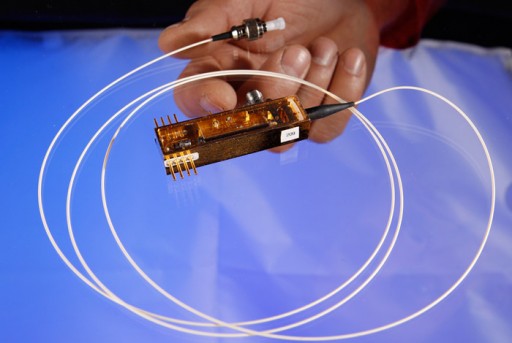Quantum cryptography to protect electric grid security
February 18, 2013

A miniature transmitter communicates with a trusted authority via fiber optic cables to generate random cryptographic keys to encode and decode information (credit: Los Alamos National Laboratory)
Los Alamos National Laboratory scientists have completed the first-ever demonstration of using quantum cryptography to make control data for electric grids secure .
Controllers for the electric distribution grid tend to be vulnerable to intrusion.
The electric grid also needs to accommodate new renewable energy sources, such as solar panels and wind generators, because their availability can fluctuate on short time scales.
Control data must be both trustworthy (with strong authentication), but also delivered without delays, which standard cryptographic techniques cannot provide (they operate too slowly).
Quantum cryptography provides a means of detecting and defeating an adversary who might try to intercept or attack the communications. Single photons are used to produce secure random numbers between users, and these random numbers are then used to authenticate and encrypt the grid control data and commands. Because the random numbers are produced securely, they act as cryptographic key material for data authentication and encryption algorithms.
At the heart of the new quantum-secured communications system is a unique, miniaturized quantum-computer transmitter invention, known as a QKarD. It is 100,000 times smaller than any competing quantum-computing device, according to Jane Nordholt, the Los Alamos principal investigator.
“This project shows that quantum cryptography is compatible with electric-grid control communications, providing strong security assurances rooted in the laws of physics, without introducing excessive delays in data delivery,” said Nordholt.
The new system provides the necessary strong security assurances, as well as latencies (time to send a message) that are at least 100 smaller than requirements — typically 250 microseconds, including 120 microseconds to traverse the 25 kilometers of optical fiber connecting the two experimental nodes.
Further, the team’s quantum-secured communications system demonstrated that this capability could be deployed with only a single optical fiber to carry the quantum, single-photon communications signals as well as data packets and commands. “Moreover, our system is scalable to multiple monitors and several control centers,” said Richard Hughes, the co-principal investigator from Los Alamos.
The Los Alamos team is seeking funding to develop a next-generation QKarD using integrated electro-photonics methods, which would be even smaller and more highly integrated, and would allow for a manufacturing process that would result in much lower unit costs.